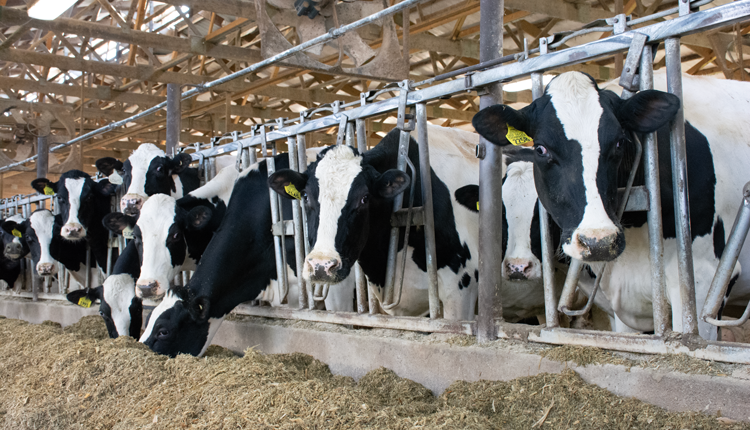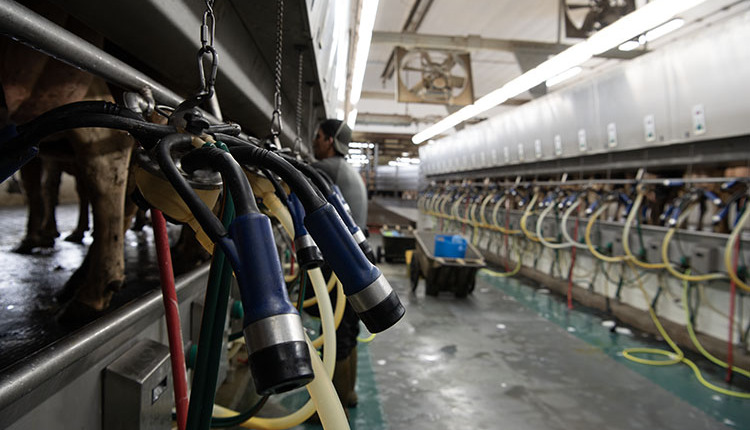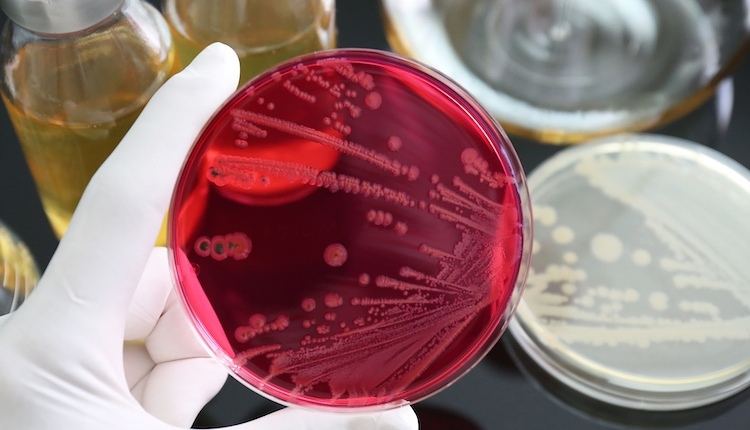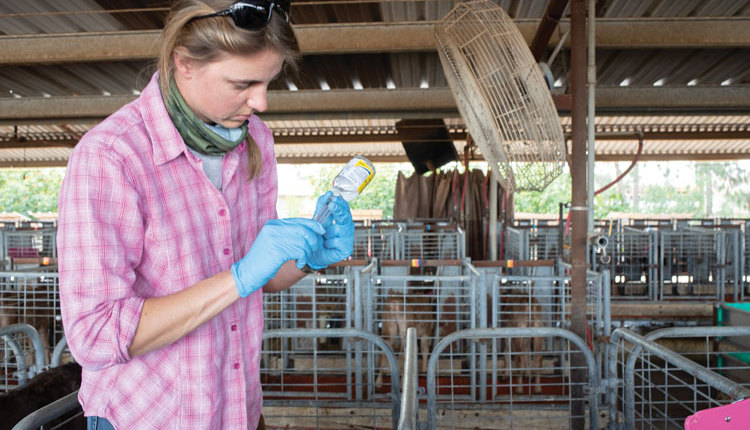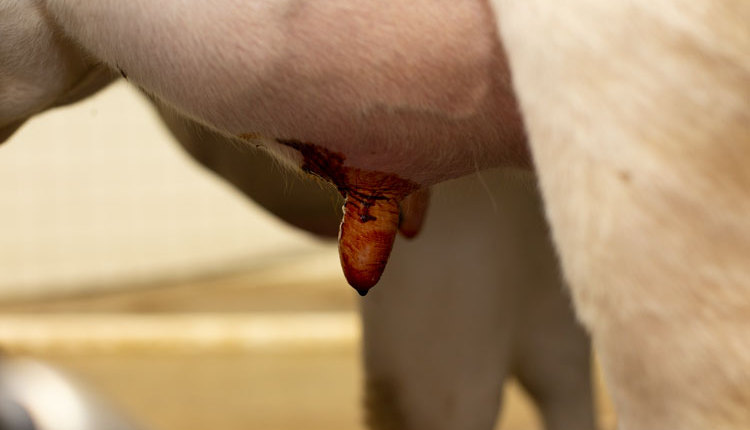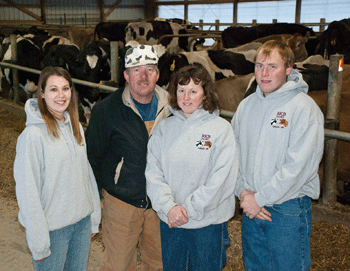
The Bauer family "never cuts corners when it comes to keeping their cows clean and comfortable on a daily basis," said nominator Doug Wertish with South Central College's farm business program. That helps explain the low somatic cell and bacteria counts at their Faribault, Minn., farm. SCC averaged just 76,202 and SPC, 2,500. Normally, two people milk. They house cows in a three-row, sand-bedded free stall barn and milk them in a swing-8 parabone parlor. Shown at center are Randy and Kathy Bauer, with daughter Melisa and son Glen.
Becky and Randy Dreier, Norwalk, Wis., are shown with their nominator, Bob Zielsdorf of Swiss Valley Farms (center). With their 72 registered Holsteins in a tunnel-ventilated tie stall barn, the Dreiers, with the help of children Derek, 19, Ashley, 16, Kelli, 12, and Jaden, 4, had an impressive SCC average of 68,833. They get monthly SCCs on each cow through DHI but also CMT each cow once a week. They double treat high-cell dry cows 10 to 14 days after dry-off. Their stalls have Pasture Mats bedded with 80 percent chopped straw and 20 percent pine shavings.
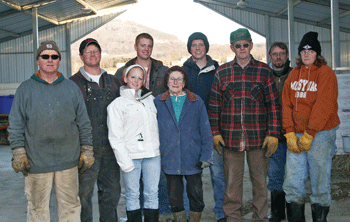
The Taylor and Alan Henderson Family, Schaghticoke, N.Y., house their 130 Holsteins in a free stall barn with rubber mats topped with pine shavings. Their prep routine is clean with paper towels, predip, foremilk, predip again, and attach. They change inflations every 1,000 milkings. The Hendersons were nominated by Jesse Vandergrift and George Pfeiffer with Archdale Ag Products, who said the health of every animal is Job Number One at Henderson Farms. "They're always looking for ways to improve milk quality."
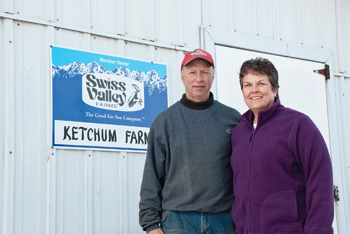
Robert and Terri Ketchum, Utica, Minn., also were nominated by Bob Zielsdorf of Swiss Valley Farms. The Ketchums had only two clinical cases among their 128 Holsteins during the past year. High cell count was 97,000 in August. They CMT fresh cows, culture those that need it, and treat accordingly. The Ketchums house cows in a sand-bedded free stall barn and milk them in a double-8 parallel. Nominator Zielsdorf says the Ketchums are very particular with the small things that result in very high-quality milk with excellent results.

The McClellan Farms crew, Delavan, Wis., had both the largest (530 cows) and highest producing (30,557 milk) herd among the Platinum winners. Nine employees do the milking following a strict protocol: dry rub with towel, predip, rub teat ends with thumb, foremilk, dry again, and attach. Housing is sand-bedded free stalls, with milking in a double-8 herringbone. McClellans double dry treat higher cell count cows about one week after dry-off. Nominator Randy Hardyman said McClellan Farms has received Grande Milk Marketing's quality award for 14 straight years, earning the highest honors last year, Grande's Platinum Award.

Michigan State University did it again . . . Platinum recognition for the second year in a row. Milking is done by five full-time employees and seven students. For the year, the 151-cow university herd had a remarkable SCC average of just 62,000. Nominator was Duane Farmer of Michigan Milk Producers co-op. Shown (l-r): Bruce Kurzhals, Michael Frazee, Alix Lyndrup, Allan Mergener, Nicholas Vito, Nate Lippert, Fred Openlander, Joe LeSarge, Roxanne Ernst, Ray Lee, Jim Kunisch, Randy Bontrager, Matt Costigan, Gordon Galloway, Rob West, Bob Story, Bob Kreft, manger, Ted Ferris, Eric Barr, and Charlie Kunisch. On the rock: Erin Nicklaw and Gail Carpenter.
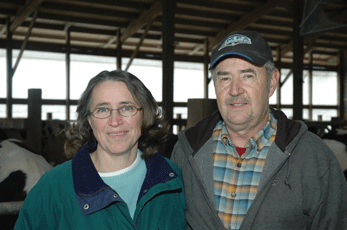
Denise and Donald Rice, Filion, Mich., house their 110 Holsteins in a sand-bedded free stall barn and milk them in a double-4 herringbone. They scrape alleys and groom stalls twice a day. Most milking is done by family members. The Rices give problematic springing heifers dry cow treatment before they calve. Then they culture heifers, if needed, and treat accordingly. Their nominator, Richard Fluegge, with Michigan Milk Producers, said the Rices have received quality awards from the co-op eight straight years, including the highest (Gold Award) this past year.
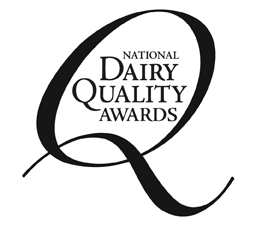
• Average herd size of the seven Platinum winners herds is 173 cows.
• Average somatic cell count of the seven farms for the 12-month period was 76,300.
• Average standard plate count for the seven farms during the year was 1,600.
• The people doing the milking at all seven farms wear gloves all or most of the time.
• During prep, five of the seven predip then strip, and two of the seven strip and then pre-dip.
• Five of the seven use reusable cloth towels, and two use paper towels.
• Six of the farms have free stalls, and two have tie stalls. Michigan State has both.
• Four of the six farms with free stalls use sand as bedding.
• All farms dry treat all cows. Two of the farms sometimes dry treat problem cows a second time.
• Six of the farms use a teat sealant following dry treatment.
These farms represent the seven best from more than 220 nominations for the annual "Q" award. Link to to see the list of the 17 farms that received Gold recognition and 22 that received Silver recognition. Listed with all of those recognized are the names of the people who nominated them. We extend our sincere thanks to the nominators and the NDQA sponsors, all of which are vital to this recognition program.
Maybe we're not all going to predip twice, double dry treat problem cows, or groom stalls up to four times a day. But there's not a lot these farms do that we all couldn't do on our own farms. You will read here the details of what they do, and we all can learn from that. But what really sets these Platinum winners apart is the extraordinary commitment, intensity, passion, and dedication evident in their practices and attitudes. Now, for what the Platinum winners do:
What is your milking procedure?
Bauer: There is a written milking procedure, and milkers wear gloves. We remove sand from teats and udder; strip four times from each quarter into the strip cup; dip; dry teats using microfiber, washable towels; attach milking units; and postdip.
Dreier: There is a written milking procedure, and Randy and Becky wear gloves. We dip, dry teats with two paper towels per cow, strip out foremilk, attach milking units, and dip with a 1 percent iodine barrier. We CMT paddle test each cow once a week.
Henderson: Some milkers wear gloves. We clean teats with a dry cow towel, predip, strip out foremilk, predip again, dry teats with a cow towel, attach milking units, and postdip.
Ketchum: There is a written procedure, and milkers wear gloves. We brush off any sand or debris from udder and teats, predip, strip out foremilk, dry teats, attach milking units, postdip.
McClellan: Milkers wear gloves. We dry wipe with a towel to remove loose dirt, predip, rub teat ends with thumb, foremilk, dry teats with microfiber cloth towels, attach milking units, and postdip.
MSU: There is a written milking procedure, and milkers wear gloves. We predip, strip out foremilk, dry teats with cloth towels, attach milking units, and postdip.
Rice: There is a written milking procedure, and milkers occasionally wear gloves. We wash udder with iodine water using clean wash towels; strip out foremilk; dry teats using clean, dry, microfiber towels; attach milking units; hand strip after milking only if a cow has udder problems or is not milked out; postdip; and sanitize milking units between cows.
How do you maintain healthy teat ends?
Bauer: By not overmilking, changing inflations on schedule, and using postdip that is suitable for the weather conditions. In cold weather, we switch from the regular postdip to cold weather dip. When it gets extremely cold, we use a powdered dip. We have a chart that indicates when we use each particular dip according to temperature and wind chill. Liner slips are adjusted immediately. We also focus on keeping days-in-milk low.
Dreier: We use premium pre- and postdips that have high levels of skin conditioning and have vacuum levels checked monthly by a dealer.
Henderson: Proper vacuum level, change inflations at 1,000 milkings, and regularly clean and replace parts in pulsators. Also, we clean and dry teat ends carefully before milking.
Ketchum: We use high emollient dips and one made for winter use starting in November. We use silicone square liners that enable us to keep a lower teat end vacuum.
McClellan: Strict milking protocols, routine equipment maintenance, clean housing, changing postdips based for weather, using sand bedding.
MSU: Annual check of milking system, including vacuum and pulsation. Use a postdip in a cup with emollient. Maintain proper take-off setting.
Rice: We use a different postdip for cows that have damaged teat ends. In summer, we use Fight Bac spray to maintain healthy teat ends.
How are your cows kept clean and comfortable?
Bauer: Our cows are housed in a three-row, sand-bedded free stall barn with curtains and four fans. Curtains are adjusted manually as needed, and the fans are on thermostats. We add sand as needed, and the stalls are dug up and stirred around to prevent the sand from becoming packed. We scrape manure and soiled bedding out of the stalls as often as possible and scrape the alleys twice a day. Plus, the stalls are groomed twice a day. The cows are automatically sprayed for flies in the return alley during summer.
Dreier: Cows are housed in New York-style tie stalls with pasture mats. Bedding is 80 percent chopped straw and 20 percent pine shavings. We scrape and bed cow platforms three times a day. We have wind tunnel ventilation using up to four fans. We run the gutter cleaner once a day and clip cows every three months.
Henderson: Cows are housed in free stalls bedded with pine shavings on rubber mats. We maintain the stalls twice a day. We clean the barn twice a day. Our barn is naturally ventilated; plus we have fans. In summer months, cows have access to pasture.
Ketchum: We bed with sand weekly. We scrape stalls for manure three times a day and alleys twice a day. We bed milking cow stalls while milking to avoid disturbing cows while eating or lying down in our three-row, naturally ventilated free stall barn with extra fan ventilation when needed.
McClellan: We have sand bedding in free stalls with large loops. We have curtain-sided barns with fans over stalls. We scrape alleys and rake stalls three times a day. We groom the stalls once a day. We aim to have adequate amounts of fresh TMR 24/7, clean water troughs weekly, provide cow brushes (mechanical or spring mounted), and have feedline sprinklers for summer.
MSU: Our stalls have rubber-filled mattresses. We put on lime twice a day and kiln-dried sawdust twice a day. We groom stalls four times a day.
Rice: We clean manure alleys and stalls twice a day. We put in sand every 10 days. We clean water troughs every other week. The barns are well ventilated and equipped with eight large fans for the hot summer months. In the winter months, we close all the curtains to ensure the barns are draft-free.
How do you detect subclinical mastitis?
Bauer: Closely monitor the DHI SCC report and use the CMT (California Mastitis Test).
Dreier: CMT, visual check and feel for hardness, and use DHI SCC counts.
Henderson: Check cows for abnormal milk or look at DHI reports.
Ketchum: Look for hard quarters or high DHI cell counts.
McClellan: DHI SCC, CMT, prestrip.
MSU: DHI test.
Rice: CMT and SCC tests.
How do you detect clinical mastitis?
Bauer: Closely watch the forestripped milk in the strip cup, and observe or feel the udder following milking.
Dreier: CMT and milk cultures.
Henderson: Forestripping.
Ketchum: Forestripping, CMT, hard quarters, temperature, placid look of cows' eyes.
McClellan: Prestrip, CMT, hard quarter.
MSU: Forestripping.
Rice: Forestripping, swelling, sensitivity, and stripping after milking.
Describe your fresh-cow monitoring.
Bauer: We watch fresh cows closely to make sure they have a good appetite and are progressing. We take temperatures if they appear off and monitor them closely.
Dreier: After first milking, screen with CMT and DHI SCC on test days.
Henderson: We watch cows closely after freshening to ensure they are eating well.
Ketchum: We use the CMT paddle four days after freshening.
McClellan: We observe cows and udders before freshening. We prestrip and check colostrum at first milking.
MSU: Check SCC. If it is greater than 300,000, we do a CMT to find the affected quarter.
Henderson: Forestripping.
Ketchum: Forestripping, CMT, hard quarters, temperature, placid look of cows' eyes.
McClellan: Prestrip, CMT, hard quarter.
MSU: Forestripping.
Rice: Forestripping, swelling, sensitivity, and stripping after milking.
Describe your fresh-cow monitoring.
Bauer: We watch fresh cows closely to make sure they have a good appetite and are progressing. We take temperatures if they appear off and monitor them closely.
Dreier: After first milking, screen with CMT and DHI SCC on test days.
Henderson: We watch cows closely after freshening to ensure they are eating well.
Ketchum: We use the CMT paddle four days after freshening.
McClellan: We observe cows and udders before freshening. We prestrip and check colostrum at first milking.
MSU: Check SCC. If it is greater than 300,000, we do a CMT to find the affected quarter.
Rice: We use a CMT when cows are first fresh and do SCC testing through MMPA at 10 to 14 days after calving.
What steps do you take at dry-off?
Bauer: Immediately following her final milking, we mark the cow's rear legs with red chalk. With clean milking gloves, we wipe one quarter with an alcohol pad, infuse a dry cow tube (Tomorrow), then use an Orbeseal tube. We then repeat for the other three quarters. Then we apply a long-lasting teat dip and allow it to dry. At this point, we move the cow directly to the dry pen. We house dry cows in loose housing bedded with cornstalks. During warmer months, we remove plywood panels from the back of the shed and use fans as needed. We scrape manure often from the yard to keep cows clean. During fly season, we pour Ultra-Boss (a permethrin) on cows.
Dreier: We base our strategy on DHI SCC on their last test and a CMT at dry-off. We put cows on a poor diet (straw) for fast dry-off. After three to five days, we milk them out, administer Quarter- master and Orbeseal. We give J-Vac at dry-off and redry treat high SCC (above 200,000) cows or those that bag up again 10 to 14 days after the first dry treatment. We move dry cows to one section of the barn bedded with 80 percent straw and 20 percent shavings. Our cows are in New York-style stalls with pasture mats and wind tunnel ventilation. We clean gutters daily.
Henderson: All cows at dry-off are completely milked out, predipped, and wiped. We infuse with Quartermaster and Orbeseal. Then they are postdipped with Udder Gold Dry. We house all dry cows in sand-bedded free stalls which are groomed once a day along with daily scraping. All dry cows have access to pasture.
Ketchum: We put cows out in a separate pen with hay and water four to five days before their dry-off date. This helps put pressure on the udder to stop lactating. Then they are milked into a bucket and treated with Tomorrow and Orbeseal, making sure the sealant is in the teat and not the udder. We house dry cows in separate sand free stalls scraped daily. We keep transition cows in a large, well-bedded shed, with wheat straw for bedding.
McClellan: If cows have lower SCC or CMT scores, they get Quartermaster and Orbeseal. Higher SCC/CMT cows get Tomorrow and T-Hexx. We restrip one week later and use Spectramast and Orbeseal. We rake sand free stalls once a day, scrape alleys once a day, and bed weekly. The dry cows are in curtain-sided barns, some with fans over stalls.
MSU: At dry-off, cows are treated with Quartermaster, Orbeseal, and dipped with T-Hexx. They also get J-5 subcutaneous. Occasionally, a cow that leaks milk after dry-off will be retreated. Stalls are rubber-filled mattresses, limed twice a day with kiln-dried sawdust put in twice a day. We groom stalls four times a day.
Rice: Three or four weeks before dry-off, we test for SCC and Johne's. If SCC came back more than 200, 000 we use CMT to see if any quarters have subclinical mastitis. If they do, we culture, then treat. We simply dry off with DC Spectramast and, at that time, ensure we clean the teat ends very well and use a pad. In summer months, we use a 30-acre pasture with plenty of shade and grass to graze on. Then, three weeks to their due date, the cows are moved to a prefresh pen and given a vaccination. The prefresh pen is an indoor straw pack with access to outside during the day.
Describe your treatment procedures.
What steps do you take at dry-off?
Bauer: Immediately following her final milking, we mark the cow's rear legs with red chalk. With clean milking gloves, we wipe one quarter with an alcohol pad, infuse a dry cow tube (Tomorrow), then use an Orbeseal tube. We then repeat for the other three quarters. Then we apply a long-lasting teat dip and allow it to dry. At this point, we move the cow directly to the dry pen. We house dry cows in loose housing bedded with cornstalks. During warmer months, we remove plywood panels from the back of the shed and use fans as needed. We scrape manure often from the yard to keep cows clean. During fly season, we pour Ultra-Boss (a permethrin) on cows.
Dreier: We base our strategy on DHI SCC on their last test and a CMT at dry-off. We put cows on a poor diet (straw) for fast dry-off. After three to five days, we milk them out, administer Quarter- master and Orbeseal. We give J-Vac at dry-off and redry treat high SCC (above 200,000) cows or those that bag up again 10 to 14 days after the first dry treatment. We move dry cows to one section of the barn bedded with 80 percent straw and 20 percent shavings. Our cows are in New York-style stalls with pasture mats and wind tunnel ventilation. We clean gutters daily.
Henderson: All cows at dry-off are completely milked out, predipped, and wiped. We infuse with Quartermaster and Orbeseal. Then they are postdipped with Udder Gold Dry. We house all dry cows in sand-bedded free stalls which are groomed once a day along with daily scraping. All dry cows have access to pasture.
Ketchum: We put cows out in a separate pen with hay and water four to five days before their dry-off date. This helps put pressure on the udder to stop lactating. Then they are milked into a bucket and treated with Tomorrow and Orbeseal, making sure the sealant is in the teat and not the udder. We house dry cows in separate sand free stalls scraped daily. We keep transition cows in a large, well-bedded shed, with wheat straw for bedding.
McClellan: If cows have lower SCC or CMT scores, they get Quartermaster and Orbeseal. Higher SCC/CMT cows get Tomorrow and T-Hexx. We restrip one week later and use Spectramast and Orbeseal. We rake sand free stalls once a day, scrape alleys once a day, and bed weekly. The dry cows are in curtain-sided barns, some with fans over stalls.
MSU: At dry-off, cows are treated with Quartermaster, Orbeseal, and dipped with T-Hexx. They also get J-5 subcutaneous. Occasionally, a cow that leaks milk after dry-off will be retreated. Stalls are rubber-filled mattresses, limed twice a day with kiln-dried sawdust put in twice a day. We groom stalls four times a day.
Rice: Three or four weeks before dry-off, we test for SCC and Johne's. If SCC came back more than 200, 000 we use CMT to see if any quarters have subclinical mastitis. If they do, we culture, then treat. We simply dry off with DC Spectramast and, at that time, ensure we clean the teat ends very well and use a pad. In summer months, we use a 30-acre pasture with plenty of shade and grass to graze on. Then, three weeks to their due date, the cows are moved to a prefresh pen and given a vaccination. The prefresh pen is an indoor straw pack with access to outside during the day.
Describe your treatment procedures.
For mild cases:
Bauer: Oxytocin for two or three days, and we rub mint lotion on the quarter for a week. Many cases will resolve on their own.
Dreier: Oxytocin intramuscular with Pirsue or Today intramammary, give two to four aspirins, and use topical Udder Comfort.
Henderson: Treat with Amoxi-Mast for three treatments.
Ketchum: Spectramast intramammary.
McClellan: Vitamin C subcutaneous/aspirin/ udder mint. Plus, we culture. If gram positive, we give Pirsue, Amoxi-Mast, or Today for three to five days. We also use oxytocin.
Bauer: Oxytocin for two or three days, and we rub mint lotion on the quarter for a week. Many cases will resolve on their own.
Dreier: Oxytocin intramuscular with Pirsue or Today intramammary, give two to four aspirins, and use topical Udder Comfort.
Henderson: Treat with Amoxi-Mast for three treatments.
Ketchum: Spectramast intramammary.
McClellan: Vitamin C subcutaneous/aspirin/ udder mint. Plus, we culture. If gram positive, we give Pirsue, Amoxi-Mast, or Today for three to five days. We also use oxytocin.
MSU: Treat with Spectramast intramammary and penicillin-G IM.
Rice: Treatments (Pirsue, Hetacin-K, Spectramast, and Today) are used as recommended on label.
For moderate cases:
Bauer: Intramuscular injection of penicillin once a day for two days, and intramammary infusion of Today tubes every 12 hours for 1-1/2 days (three tubes).
Dreier: Oxytocin intramuscular, treat with Pirsue or Spectramast intramammary, give Banamine intramuscular, and use Udder Comfort.
Henderson: Treat with Today for two treatments.
Ketchum: Treat with Today or Spectramast intramammary.
McClellan: Same as for mild cases.
MSU: Same as for mild cases.
Rice: The same treatments as used for mild cases.
For severe cases:
Bauer: Intramuscular injection of penicillin once a day for three days, and intramammary infusion of Today tubes every 12 hours for 1-1/2 days (three tubes), oxytocin, mint lotion, aspirin twice a day.
Dreier: Oxytocin intramuscular, treat with Pirsue, Spectramast, or Hetacin intramammary, Banamine intramuscular, two to four aspirins, and IV dextrose.
Henderson: Treat with Spectramast, and take temperatures. High temperatures are treated with Naxcel intramuscular.
Ketchum: Treat with Today or other drug, depending on culture results.
McClellan: Vitamin C subcutaneous/udder mint/Banamine IM, hypertonic saline IV, Spectramast intramammary culture. We also use oxytocin.
MSU: Same as for moderate cases, plus Banamine and IV fluids.
Rice: Persistent cows are milked out and dry treated for next lactation.
Describe your record system for keeping track of cows currently being treated.
Rice: Treatments (Pirsue, Hetacin-K, Spectramast, and Today) are used as recommended on label.
For moderate cases:
Bauer: Intramuscular injection of penicillin once a day for two days, and intramammary infusion of Today tubes every 12 hours for 1-1/2 days (three tubes).
Dreier: Oxytocin intramuscular, treat with Pirsue or Spectramast intramammary, give Banamine intramuscular, and use Udder Comfort.
Henderson: Treat with Today for two treatments.
Ketchum: Treat with Today or Spectramast intramammary.
McClellan: Same as for mild cases.
MSU: Same as for mild cases.
Rice: The same treatments as used for mild cases.
For severe cases:
Bauer: Intramuscular injection of penicillin once a day for three days, and intramammary infusion of Today tubes every 12 hours for 1-1/2 days (three tubes), oxytocin, mint lotion, aspirin twice a day.
Dreier: Oxytocin intramuscular, treat with Pirsue, Spectramast, or Hetacin intramammary, Banamine intramuscular, two to four aspirins, and IV dextrose.
Henderson: Treat with Spectramast, and take temperatures. High temperatures are treated with Naxcel intramuscular.
Ketchum: Treat with Today or other drug, depending on culture results.
McClellan: Vitamin C subcutaneous/udder mint/Banamine IM, hypertonic saline IV, Spectramast intramammary culture. We also use oxytocin.
MSU: Same as for moderate cases, plus Banamine and IV fluids.
Rice: Persistent cows are milked out and dry treated for next lactation.
Describe your record system for keeping track of cows currently being treated.
Bauer: Red duct tape around both rear ankles. Cows are written down on the whiteboard in the parlor. We put cows in the special needs pen and milk them last. We enter treatments in a notebook that is kept in the barn. We record the cow ID, date, reason for treatment, type of antibiotic used, and date the milk tested negative. We write treatment information down in a card file that contains individual cow information.
Dreier: Cows have a red leg band on both hind legs. They are logged on a clipboard in the milk house area by name and DHI visual number. We use the milk house logbook to track any problems or repeat cases along with DHI monthly SCC tests and milk cultures.
Henderson: Treated cows are written on a blackboard in the parlor. Cows are tagged with red velcro bands on each leg and are recorded in a treatment book for mastitis cases. Individual cow pages have history of cow's diseases.
Ketchum: Bright pink leg bands. We enter treatments in our Scout dairy computer program from Minnesota DHIA.
McClellan: They are segregated in hospital pen. We put red tape on legs. With Dairy Comp 305, we have a daily hospital pen report with handwritten notes of treatment and status.
MSU: We put yellow leg bands on a rear leg and the front of tie stall. Also, there is a list of nonsaleable milk cows in the parlor. We enter the daily logbook of all treatments and events into Dairy Comp 305. We keep Dairy Comp 305 and individual cow paper files up to date.
Rice: We put a red leg band on both back legs if the cow is treated or milk needs to be discarded. We write all treatments on a treatment calendar (the kind of treatment and when and how often it is given).
Dreier: Cows have a red leg band on both hind legs. They are logged on a clipboard in the milk house area by name and DHI visual number. We use the milk house logbook to track any problems or repeat cases along with DHI monthly SCC tests and milk cultures.
Henderson: Treated cows are written on a blackboard in the parlor. Cows are tagged with red velcro bands on each leg and are recorded in a treatment book for mastitis cases. Individual cow pages have history of cow's diseases.
Ketchum: Bright pink leg bands. We enter treatments in our Scout dairy computer program from Minnesota DHIA.
McClellan: They are segregated in hospital pen. We put red tape on legs. With Dairy Comp 305, we have a daily hospital pen report with handwritten notes of treatment and status.
MSU: We put yellow leg bands on a rear leg and the front of tie stall. Also, there is a list of nonsaleable milk cows in the parlor. We enter the daily logbook of all treatments and events into Dairy Comp 305. We keep Dairy Comp 305 and individual cow paper files up to date.
Rice: We put a red leg band on both back legs if the cow is treated or milk needs to be discarded. We write all treatments on a treatment calendar (the kind of treatment and when and how often it is given).
